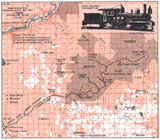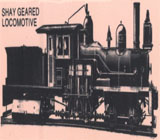The North West Lumber Company
At the same time J.D. McArthur was also building a standard guage railway under the Charter of the Canada Central Railway Company, which commenced at Dewar and was planned to run south-east through Bonneyville and Durlingville to the provincial boundary. Forty miles were eventually graded and steel laid to mile 11 by December, 1915. A major logging spur went north about mile 8. Logging in the area ceased in 1919 when in late May and early June major forest fires effected over seven million acres in eastern Alberta and Saskatchewan. Most of the town of Lac La Biche was destroyed.
The North West Lumber Company then moved up into an area north-east of Green Court (Greencourt). Here Timber berth 1192 had been awarded to T.A. Burrows, M.P., in December 1904, but nothing had been done. The Lumber company acquired the lease in 1921 and commenced logging in 1922. It was a widespread operation and several logging camps were established over the years. In order to bring the logs over to the Canadian National Railway line a standard guage line was built into the berth from which temporary spurs were extended. The logs were hauled on cars, pulled, during the initial stages of the operation, either by a saddle-tank engine or a Mogal (2-6-0), but later by either of two Shay locomotives. A fire of serious proportions occured in 1928 apparently started from sparks thrown by one of the Shays in which 5,460 F.B.M. in Logdecks were destroyed along with machinery and a mile of track. Operations ended in 1932 and the lease cancelled in 1933, but not before 335 million F.B.M. of spruce logs had been cut. The mill at Edmonton also ceased operations in 1933. It was sold to E.I. Clark of the Beverly Coal Mines but was apparently idle when it burned to the ground in May, 1937.
In the fall of 1915 J.D. McArthur purchased a timber limit on the north shore of Lesser Slave Lake, though there is no evidence that this was logged. Another operation was on Dog Island at the eastern end of the Lake from which logs were floated across and loaded on to ED&BCR cars and hauled to the mill at Edmonton.
Shay Locomotives
This type of locomotive was designed by Ephraim Shay for his logging business in Michigan. He sold his patent to the Locomotive and Machine Company in 1880. The engine has vertical cylinders offset by a horizontal tapered boiler, usually on the left. Power is transmitted to four-wheel swiveling trucks by a combination of rods, shafts, universal joint, and beveled gears. Though slow, the great adhesion provided by this mechanical arrangement enables the Shay to work well on the light, roughly laid, track.


